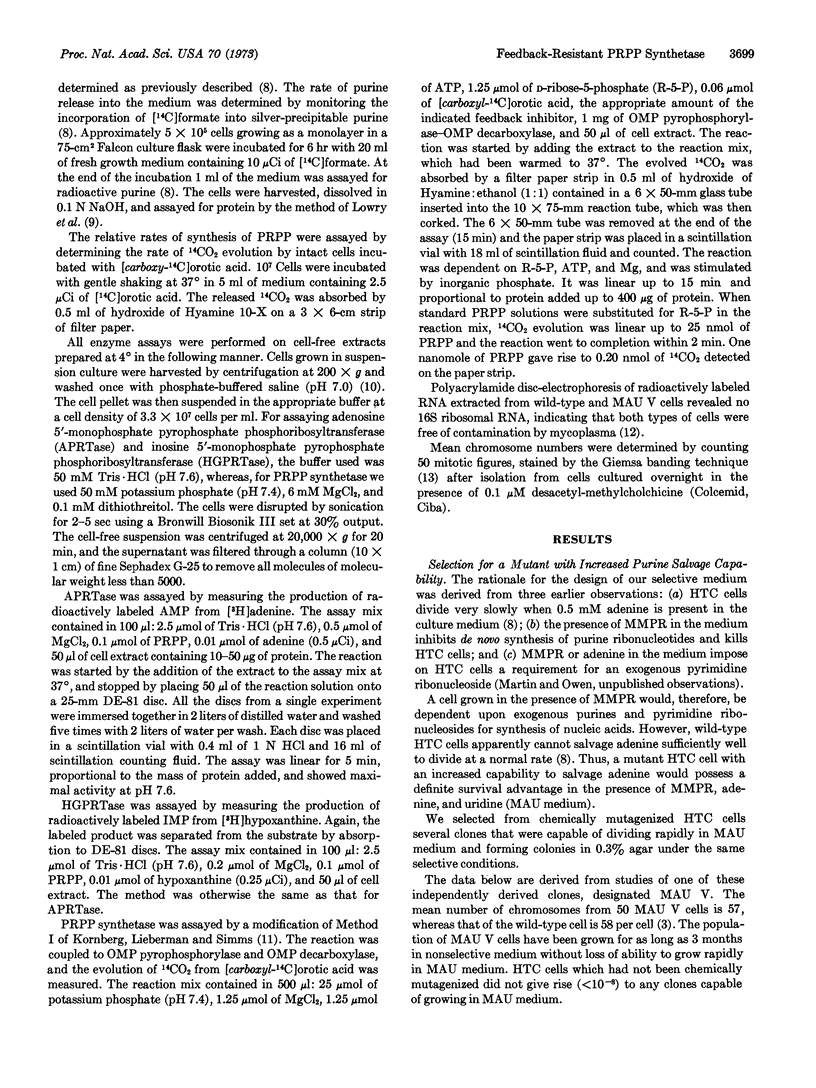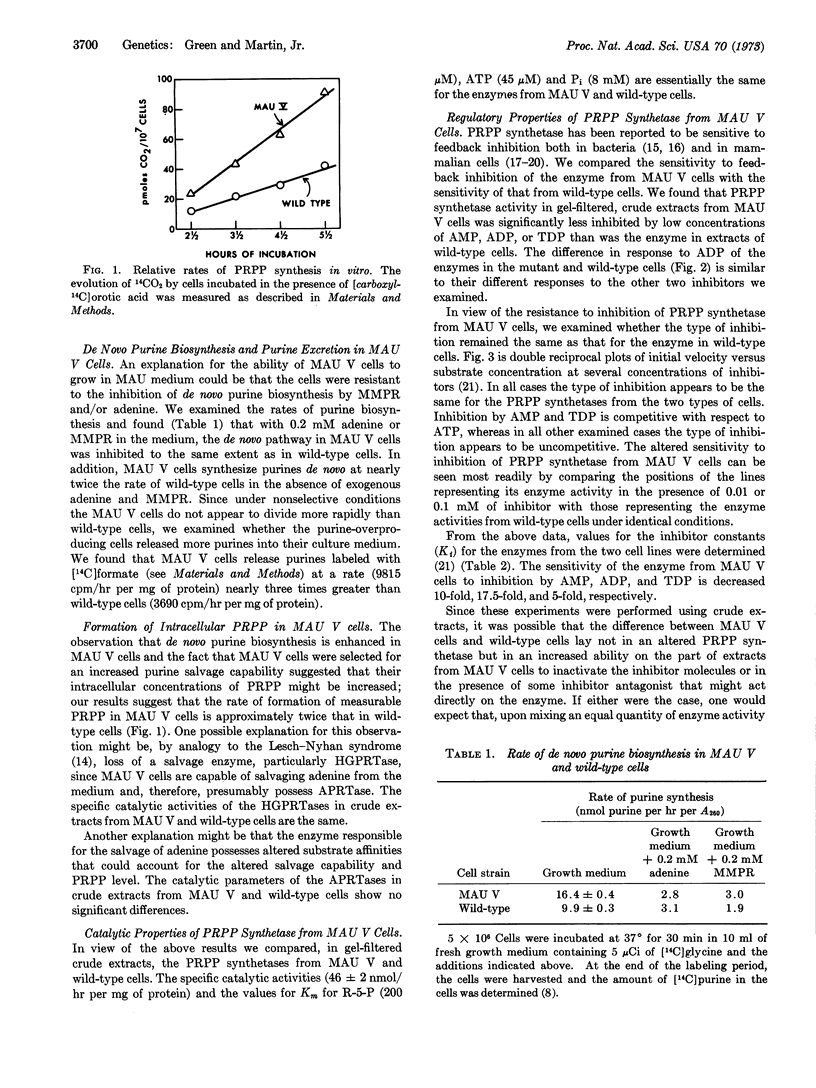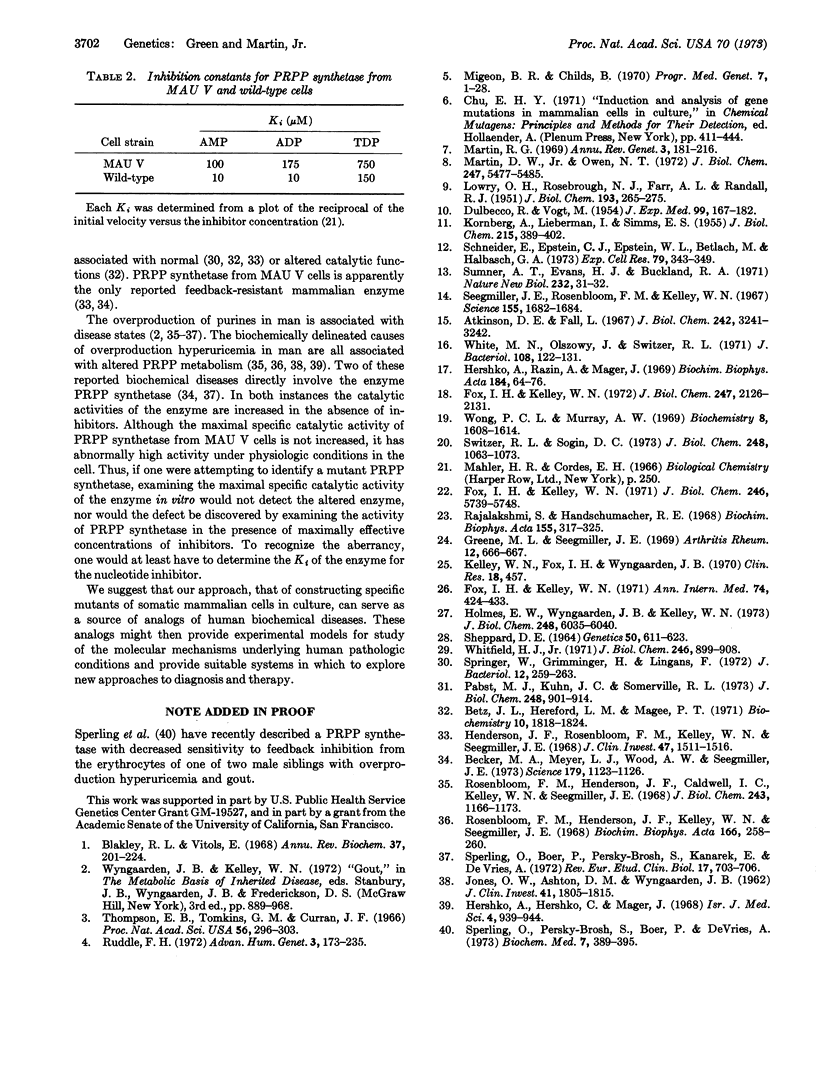Abstract
A clone of cells in which the regulation of purine metabolism is genetically altered was selected and isolated from chemically mutagenized HTC cells (a line of rat hepatoma cells in continuous culture). The clone, designated MAU V, was selected for increased ability to salvage exogenous purines by isolating it in medium containing methylmercaptopurine ribonucleoside, adenine, and uridine, in which medium wild-type cells cannot divide. We have characterized these cells as having an increased rate of de novo purine biosynthesis, apparently as the result of an altered phosphoribosylpyrophosphate (PRPP) synthetase. The altered enzyme has normal catalytic properties but an altered sensitivity to feedback inhibition by purine and pyrimidine nucleotides. The types of inhibitions (competitive and uncompetitive) exerted by AMP, ADP, and TDP on the wild-type enzyme have been maintained in the altered enzyme, but values for Ki have been increased by factors of 10, 17.5, and 5, respectively. The specific catalytic activities of AMP: pyrophosphate phosphoribosyltransferase and IMP:pyrophosphate phosphoribosyltransferase are normal. The mutant cell may serve as a model for a specific human disease, one type of dominantly inherited overproduction hyperuricemia.
Keywords: HTC cells, somatic cell mutants, methylmercaptopurine ribonucleoside, purine biosynthesis, hyperuricemia
Full text
PDF




Selected References
These references are in PubMed. This may not be the complete list of references from this article.
- Atkinson D. E., Fall L. Adenosine triphosphate conservation in biosynthetic regulation. Escherichia coli phosphoribosylpyrophosphate synthase. J Biol Chem. 1967 Jul 10;242(13):3241–3242. [PubMed] [Google Scholar]
- Becker M. A., Meyer L. J., Wood A. W., Seegmiller J. E. Purine overproduction in man associated with increased phosphoribosylpyrophosphate synthetase activity. Science. 1973 Mar 16;179(4078):1123–1126. doi: 10.1126/science.179.4078.1123. [DOI] [PubMed] [Google Scholar]
- Betz J. L., Hereford L. M., Magee P. T. Threonine deaminases from Saccharomyces cerevisiae mutationally altered in regulatory properties. Biochemistry. 1971 May 11;10(10):1818–1824. doi: 10.1021/bi00786a014. [DOI] [PubMed] [Google Scholar]
- Blakley R. L., Vitols E. The control of nucleotide biosynthesis. Annu Rev Biochem. 1968;37:201–224. doi: 10.1146/annurev.bi.37.070168.001221. [DOI] [PubMed] [Google Scholar]
- DULBECCO R., VOGT M. Plaque formation and isolation of pure lines with poliomyelitis viruses. J Exp Med. 1954 Feb;99(2):167–182. doi: 10.1084/jem.99.2.167. [DOI] [PMC free article] [PubMed] [Google Scholar]
- Fox I. H., Kelley W. N. Human phosphoribosylpyrophosphate synthetase. Distribution, purification, and properties. J Biol Chem. 1971 Sep 25;246(18):5739–5748. [PubMed] [Google Scholar]
- Fox I. H., Kelley W. N. Human phosphoribosylpyrophosphate synthetase. Kinetic mechanism and end product inhibition. J Biol Chem. 1972 Apr 10;247(7):2126–2131. [PubMed] [Google Scholar]
- Fox I. H., Kelley W. N. Phosphoribosylpyrophosphate in man: biochemical and clinical significance. Ann Intern Med. 1971 Mar;74(3):424–433. doi: 10.7326/0003-4819-74-3-424. [DOI] [PubMed] [Google Scholar]
- Henderson J. F., Rosenbloom F. M., Kelley W. N., Seegmiller J. E. Variations in purine metabolism of cultured skin fibroblasts from patients with gout. J Clin Invest. 1968 Jul;47(7):1511–1516. doi: 10.1172/JCI105844. [DOI] [PMC free article] [PubMed] [Google Scholar]
- Hershko A., Hershko C., Mager J. Increased formation of 5-phosphoriboxyl-1-pyrophosphate in red blood cells of some gouty patients. Isr J Med Sci. 1968 Sep-Oct;4(5):939–944. [PubMed] [Google Scholar]
- Hershko A., Razin A., Mager J. Regulation of the synthesis of 5-phosphoribosyl-I-pyrophosphate in intact red blood cells and in cell-free preparations. Biochim Biophys Acta. 1969 Jun 17;184(1):64–76. doi: 10.1016/0304-4165(69)90099-3. [DOI] [PubMed] [Google Scholar]
- Holmes E. W., Wyngaarden J. B., Kelley W. N. Human glutamine phosphoribosylpyrophosphate amidotransferase. Two molecular forms interconvertible by purine ribonucleotides and phosphoribosylpyrophosphate. J Biol Chem. 1973 Sep 10;248(17):6035–6040. [PubMed] [Google Scholar]
- JONES O. W., Jr, ASHTON D. M., WYNGAARDEN J. B. Accelerated turnover of phosphoribosylpyrophosphate, a purine nucleotide precursor, in certain gouty subjects. J Clin Invest. 1962 Sep;41:1805–1815. doi: 10.1172/JCI104638. [DOI] [PMC free article] [PubMed] [Google Scholar]
- KORNBERG A., LIEBERMAN I., SIMMS E. S. Enzymatic synthesis and properties of 5-phosphoribosylpyrophosphate. J Biol Chem. 1955 Jul;215(1):389–402. [PubMed] [Google Scholar]
- LOWRY O. H., ROSEBROUGH N. J., FARR A. L., RANDALL R. J. Protein measurement with the Folin phenol reagent. J Biol Chem. 1951 Nov;193(1):265–275. [PubMed] [Google Scholar]
- Martin D. W., Jr, Owen N. T. Repression and derepression of purine biosynthesis in mammalian hepatoma cells in culture. J Biol Chem. 1972 Sep 10;247(17):5477–5485. [PubMed] [Google Scholar]
- Migeon B. R., Childs B. Hybridization of mammalian somatic cells. Prog Med Genet. 1970;7:1–28. [PubMed] [Google Scholar]
- Pabst M. J., Kuhn J. C., Somerville R. L. Feedback regulation in the anthranilate aggregate from wild type and mutant strains of Escherichia coli. J Biol Chem. 1973 Feb 10;248(3):901–914. [PubMed] [Google Scholar]
- Rajalakshmi S., Handschumacher R. E. Control of purine biosynthesis de novo by orotic acid in vivo and in vitro. Biochim Biophys Acta. 1968 Feb 26;155(2):317–325. doi: 10.1016/0005-2787(68)90176-7. [DOI] [PubMed] [Google Scholar]
- Rosenbloom F. M., Henderson J. F., Caldwell I. C., Kelley W. N., Seegmiller J. E. Biochemical bases of accelerated purine biosynthesis de novo in human fibroblasts lacking hypoxanthine-guanine phosphoribosyltransferase. J Biol Chem. 1968 Mar 25;243(6):1166–1173. [PubMed] [Google Scholar]
- Rosenbloom F. M., Henderson J. F., Kelly W. N., Seegmiller J. E. Accelerated purine biosynthesis de novo in skin fibroblasts deficient in hypoxanthine--guanine phosphoribosyltransferase activity. Biochim Biophys Acta. 1968 Aug 23;166(1):258–260. doi: 10.1016/0005-2787(68)90512-1. [DOI] [PubMed] [Google Scholar]
- Ruddle F. H. Linkage analysis using somatic cell hybrids. Adv Hum Genet. 1972;30:173–235. doi: 10.1007/978-1-4757-4429-3_4. [DOI] [PubMed] [Google Scholar]
- SHEPPARD D. E. MUTANTS OF SALMONELLA TYPHIMURIUM RESISTANT TO FEEDBACK INHIBITION BY L-HISTIDINE. Genetics. 1964 Oct;50:611–623. doi: 10.1093/genetics/50.4.611. [DOI] [PMC free article] [PubMed] [Google Scholar]
- Schneider E. L., Epstein C. J., Epstein W. L., Betlach M., Halbasch G. A. Detection of mycoplasma contamination in cultured human fibroblasts. Comparison of biochemical and microbiological techniques. Exp Cell Res. 1973 Jun;79(2):343–349. doi: 10.1016/0014-4827(73)90453-9. [DOI] [PubMed] [Google Scholar]
- Seegmiller J. E., Rosenbloom F. M., Kelley W. N. Enzyme defect associated with a sex-linked human neurological disorder and excessive purine synthesis. Science. 1967 Mar 31;155(3770):1682–1684. doi: 10.1126/science.155.3770.1682. [DOI] [PubMed] [Google Scholar]
- Sperling O., Boer P., Persky-Brosh S., Kanarek E., De Vries A. Altered kinetic property of erythrocyte phosphoribosylpsyrophosphate synthetase in excessive purine production. Rev Eur Etud Clin Biol. 1972 Aug-Sep;17(7):703–706. [PubMed] [Google Scholar]
- Sperling O., Persky-Brosh S., Boer P., De Vries A. Human erythrocyte phosphoribosylpyrophosphate synthetase mutationally altered in regulatory properties. Biochem Med. 1973 Jun;7(3):389–395. doi: 10.1016/0006-2944(73)90059-8. [DOI] [PubMed] [Google Scholar]
- Springer W., Grimminger H., Lingens F. Isoleucine auxotrophy due to feedback hypersensitivity of biosynthetic threonine deaminase. J Bacteriol. 1972 Oct;112(1):259–263. doi: 10.1128/jb.112.1.259-263.1972. [DOI] [PMC free article] [PubMed] [Google Scholar]
- Sumner A. T., Evans H. J., Buckland R. A. New technique for distinguishing between human chromosomes. Nat New Biol. 1971 Jul 7;232(27):31–32. doi: 10.1038/newbio232031a0. [DOI] [PubMed] [Google Scholar]
- Switzer R. L., Sogin D. C. Regulation and mechanism of phosphoribosylpyrophosphate synthetase. V. Inhibition by end products and regulation by adenosine diphosphate. J Biol Chem. 1973 Feb 10;248(3):1063–1073. [PubMed] [Google Scholar]
- Thompson E. B., Tomkins G. M., Curran J. F. Induction of tyrosine alpha-ketoglutarate transaminase by steroid hormones in a newly established tissue culture cell line. Proc Natl Acad Sci U S A. 1966 Jul;56(1):296–303. doi: 10.1073/pnas.56.1.296. [DOI] [PMC free article] [PubMed] [Google Scholar]
- White M. N., Olszowy J., Switzer R. L. Regulation and mechanism of phosphoribosylpyrophosphate synthetase: repression by end products. J Bacteriol. 1971 Oct;108(1):122–131. doi: 10.1128/jb.108.1.122-131.1971. [DOI] [PMC free article] [PubMed] [Google Scholar]
- Whitfield H. J., Jr Purification and properties of the wild type and a feedback-resistant phosphoribosyladenosine triphosphate pyrophosphate phosphoribosyltransferase, the first enzyme of histidine biosynthesis in Salmonella typhimurium. J Biol Chem. 1971 Feb 25;246(4):899–908. [PubMed] [Google Scholar]
- Wong P. C., Murray A. W. 5-Phosphoribosyl pyrophosphate synthetase from Ehrlich ascites tumor cells. Biochemistry. 1969 Apr;8(4):1608–1614. doi: 10.1021/bi00832a042. [DOI] [PubMed] [Google Scholar]


